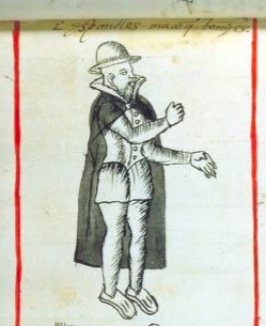español (Chav1)
This example of iconography consists of a black-line drawing of a Spaniard, referred to in the Nahuatl text as one of several "españoles" (Spaniards, using a loanword from Spanish) who received money from the town. It is a man who is standing, shown in a three-quarter perspective, looking toward the viewer's right. He wears a hat, a black cape with a high collar, a light-colored button-down belted tunic over light trousers, and light-colored shoes. He is gesturing with both arms.
Stephanie Wood
Note, below, how some Indigenous authorities were already dressing like Spaniards.
Stephanie Wood
Espanoles
españoles
Stephanie Wood
1578
Jeff Haskett-Wood
etnicidades, colonizadores, castellanos, imperialismo europeo, imperialismo español, señalar con las manos, mapilhuia, mahpilhuia
español, a Spaniard, https://nahuatl.wired-humanities.org/content/espa%C3%B1ol
mapilhuia, to point a finger, https://nahuatl.wired-humanities.org/content/mapilhuia
un español
Stephanie Wood
The Codex Chavero of Huexotzinco (or Códice Chavero de Huexotzinco), https://www.loc.gov/resource/gdcwdl.wdl_03246_001/?sp=1
The Codex Chavero of Huexotzinco (or Códice Chavero de Huexotzinco) is held by the Instituto Nacional de Antropología e Historia, México. It is published online by the World Digital Library and the Library of Congress, which is “unaware of any copyright or other restrictions in the World Digital Library Collection.”


